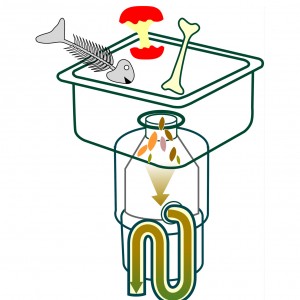
Don’t Let Dishes Pile Up in the Sink
Dishes in the sink are a major hazard to a garbage disposal because of the tendency of smaller pieces like silverware and small drinking glasses to find their way down the kitchen sink drain, waiting to wreak havoc on your garbage disposal and pipe upon the flip of that garbage disposal switch. Be especially mindful of small, tricky glasses that happen to be the exact same size as your sink drain—they can slip right down into the drain, and if they’re clear, you might not even realize that they’re there.
Watch What You’re Putting Down the Drain
Certain foods should be reserved for the trash can instead of the garbage disposal. Here are a few examples:
- Grease. Grease is dangerous because, while it can be poured down a kitchen sink drain, it will solidify as it cools and clog your pipes. Instead, pour it into a foil-lined cup, let it cool, and then ball of the foil with the solidified grease and toss it. Related foods like oils, butter, and margarine can also wreak the same type of havoc in your piping system.
- Pasta and rice. These foods have a tendency to expand, meaning bad news for your pipes if they happen to collect pieces of pasta or rice in them.
- Flour. Flour becomes sticky and glue-like when wet, then hardens when it’s dry. This means it can easily stick to the sides of your pipes and then harden while still in your pipes.
- Starchy vegetables. Like flour, these can become glue-like as they are ground up and become wet.
- Stringy foods. This means foods like celery, corn husks, and asparagus but also includes raw meat. These foods have the potential to wrap around the garbage disposal blades and cause a jam.
- Large fruit peels and rinds. Your disposal may sound strong, but tough fruit skins and rinds are still difficult to break down there. Moreover, these are often too large for the disposal.
- Non-food items. Things like flower stems, coffee filters, and cigarette butts simply shouldn’t enter your kitchen sink’s drain system.
A good, safe measure is to refrain from putting any large bits of food down the drain—if you find yourself needing to dispose of a plate full of untouched food, send it to your trash or compost bin instead of the garbage disposal.
Run It with Plenty of Cold Water
This means running plenty of water before, during, and after running the garbage disposal. Cold water is best because hot water as a tendency to melt foods that will only harden later as they travel down your pipes. It is much better for foods to be ground up from the get-go.